
Featured Blog | This community-written post highlights the best of what the game industry has to offer. Read more like it on the Game Developer Blogs or learn how to Submit Your Own Blog Post
Deconstructing PC Building Simulator product strategy
Once a game reaches maturity, how can it keep generating revenue and maintain player interest? We talk about that while analyzing the challenges and opportunities on PC Building Simulator.

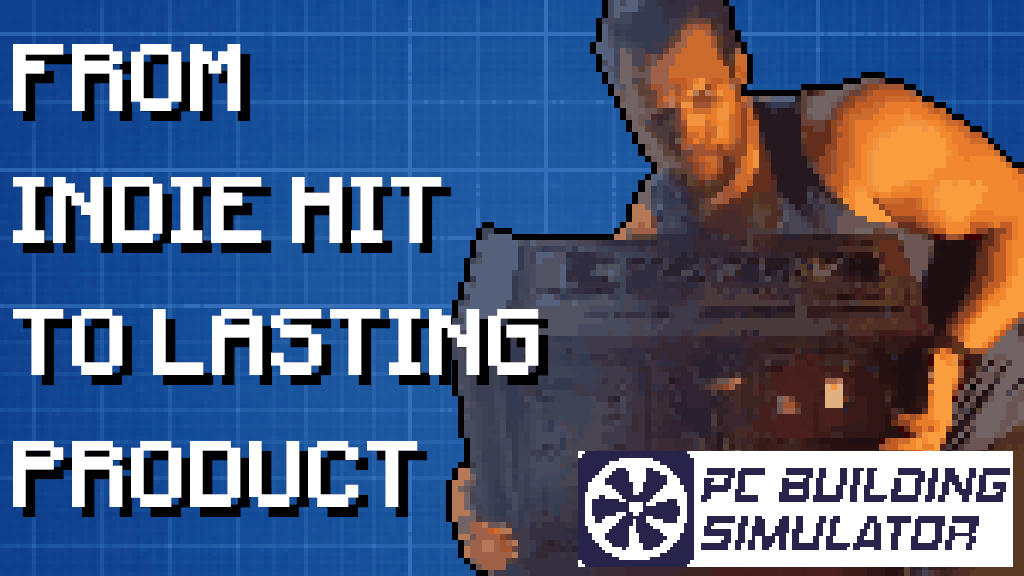
[DISCLAIMER] I'm not affiliated in any way to The Irregular Corporation or PC Building Simulator. The opinions on this article are my own and the data, unless stated otherwise, is made up to act as examples.
A few weeks ago I had the opportunity to speak with some of the masterminds behind PC Building Simulator. So I decided to play it for a bit. Just enough to get why there’s so many people streaming about it. It was a bad mistake: PCBS it’s addictive as hell.
Unfortunately, in my humble opinion, as it stands right now PCBS is far from achieving its full grossing potential, and not as good as it could be at maintain its current momentum: After a mere ~10h, the player has squeezed all the content from the main game & DLCs. And new content which adds meaningful reasons to stay is not added with enough periodicity to keep players engaged.
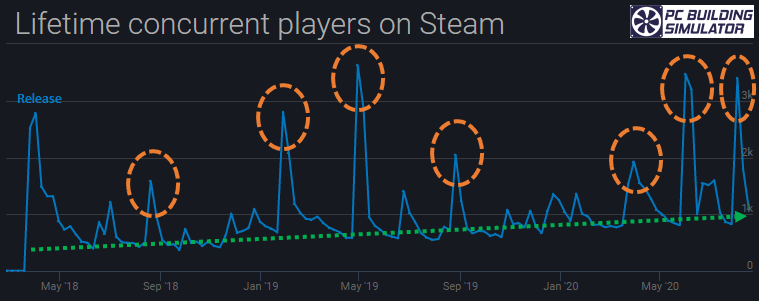
Purchase price offers and DLC releases generate population spikes (orange circles). Note how PCBS doesn’t transform much of that into regulars (green line). They do come in, but leave fast. Source.
This article aims to explain what happens when a game reaches a maturity stage, and how to turn it into a service so it keeps generating revenue and maintains player interest for a longer time. What PCBS needs to go from a indie hit into a lasting product…
WHAT IS PC BUILDING SIMULATOR?
You might be surprise, but it’s actually slightly different than what it says on the tin. While the main interaction is about assembling components, the gameplay is in fact about running a PC repair shop.
Over the course of the Career mode & eSports DLC, the player has not only to tinker with PCs. But also listen to customer requests, diagnose broken PCs, check component prices to make sure the repair is kept under budget and manage delivery times…

Career causes most of the moments highlighted by streamers: Failing to diagnose why a PC doesn’t work, sending an expensive component to a customer for free, forgetting thermal paste…
PCBS has a simple core loop which is very effective at creating the just one more turn effect (fixing just one more PC, completing just one more day…).
As player progresses, harder jobs start appearing which may require to overclock the PC or even reach specific 3dMark scores… Unfortunately, that kind of content is quite limited: there are few mechanics to unlock, and not many shop upgrades to buy…

FREE MODE? A DEAD END!
PCBS does include a Free Mode where the player can relax by tinkering while disregarding component costs or profitability. Just enjoying the usage of real components from real brands.
This sandbox mode certainly appeals the most enthusiastic fans of PC building. But it offers very limited possibilities to generate broader player interest or sustain any monetization at all. It doesn’t provide reasons for the player to stay for long.
As a consequence, the creative direction seems to be putting the focus away from it: Their first major DLC is focused around eSports and puts emphasis on adding a new storyline and several extra game mechanics.
WHAT’S NEXT FOR THEM?
With sales estimations well above 1 million, it’s safe to say that PC Building Simulator has reached the status of an indie hit. But it takes more than that to become a lasting product.
ARE THERE ALTERNATIVES TO BE A LONG LIVED PRODUCT?
Maybe the developers would prefer a shorter lived product so they can release sequels, or even annual releases like FIFA…
However, I believe making sequential releases is not the way to go on the Simulation genre. Contrary to sport franchises, where rosters change every year, in Simulation themes there are few differences over a short span of time like a year.
So players would have few incentives to move towards the next product of the line.

The strategy of many sims is to keep products alive for a long time, and monetize further through DLCs.
With this I’m not necessarily saying that the developers shouldn’t work on a sequel. There are several problems with PCBS in terms of tech and core mechanics which might be easier to solve by starting from scratch…
But if they do a sequel, they should plan it in a way that it’s thought as a product that can sustain itself in the market for a long time, rather than a title on a list of sequels.
In that regard, PCBS faces two main challenges:
CHALLENGE #1: POST-PURCHASE MONETIZATION STRATEGY
So far, most of the revenue of PCBS comes exclusively from the purchase price.
Sales are boosted by regular discounts of a growing size, exploring every point of the price elasticity curve. A classic strategy which apparently has worked very well so far. This is great news on the short term, since PCBS still has several big bullets to shoot when it comes to discounts (they recently hit the -50% milestone, which means they still have -75%, -90%…).
But without the ability to successfully monetize further their already existing audience through post-purchase content, PCBS won’t be able to keep on performing on the long run. And right now, they are already leaving a lot of money on of the table, since their best customers are those that already payed for the game at higher price points.
CHALLENGE #2: INCREASE DAILY ACTIVE USERS
Active Users isn’t just a vanity metric.
Even if PCBS is a paid game, having a big population of highly engaged players means a broader potential market for DLC content (monetizing players further than just the purchase price) and more people speaking about it (fostering more people learning about the game and generating new purchases).
Fair: Regardless of how much we nerds love it, assembling PCs might not become a mainstream theme ever. (Even though, PC building is something growing in popularity, specially among younger audieces).

Last July, Henry Cavill (Superman, Geralt of Rivia…) uploaded a notorious video assembling a gaming PC build from scratch. He got 200% more views and comments than on his other videos.
FOCUS ON PLAYER RETENTION
Nevertheless, the opportunity with Active Users on PCBS is not related with the size of the niche, but with increasing the player retention.
We already saw the graph of the regular population growing very slowly. But there are several other engagement indicators that we can also use to infer that the player retention has significant potential to improve:
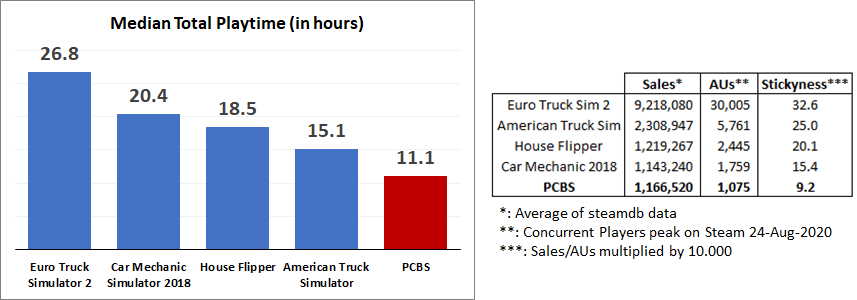
If we put the data from a few simulators in comparison, it doesn’t look too good for PCBS: Players seem to leave the game faster, and play less regularly than other sims. Are they depleting the content?
Improving this KPI would mean a massive change on the future performance of PCBS, opening the door for it to grow beyond its current grossing tier.
For example, Euro Truck Simulator 2 achieved a constant population growth over a very long time. Now, it’s in the Top 25 most played on Steam. They have more active players than on Red Dead Redemption 2 or The Witcher 3 (!!!)

Summarizing, to turn PCBS into a long lasting hit, there are 2 objectives:
Make players generate revenue after the game purchase (add monetization)
Keep players engaged for a longer time (improve retention)
How to achieve this?
First, let’s take a step back to examine the pieces we need to touch…
THE ANATOMY OF A MATURE GAME
Naturally, in games that are young and growing, there will be more new players in early stages than old players that have depleted the content and are located at the end. But eventually, as they advance, players will start to accumulate at the last point of the progression.
Over time, the flow of new players will become smaller than the amount of old players, and the DAU distribution will look something like this:
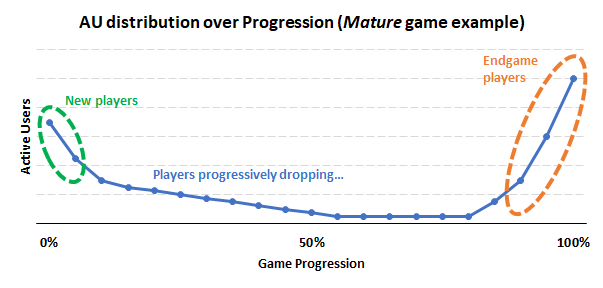
This would be a population snapshot of a single specific day on a mature game: new players come in, and then there’s a group of hardcore fans that accumulates at the end of the progression. Bursts of user acquisition, store featurings or discounts temporarily may alter the shape temporarily, but ultimately the older a game is, the more it will tend to look like a U or a J.
This means that a live game has 2 big audiences, based on their progression:
New players, which are still consuming the already existing game content for the first time and will either grow into old players or get bored and leave (churned).
It’s way harder to monetize these players, specially in paid games, since they still don’t know if they enjoy the game enough to do further investment, and they have plenty of starter content anyway.
For the most part, adding new endgame content won’t make them stay instead of leaving (improve their retention), because they aren’t there yet. Instead, their retention is primarily affected by the quality of the content they’re currently playing.
Old players, which already have finished most of the content and they like the game a lot, since they didn’t churn yet. They also tend to have more voice on social networks and such, since they’re very engaged with the game and have been playing for a while.
These users are typically the most valuable when it comes to monetization, because they’ve ran out of content and want more (since they like the game).
Of course, they will eventually leave the game if they’re not presented with regular meaningful content, or some other way on which the game doesn’t turn repetitive (multiplayer, PVP…)
INVEST ON OLD PLAYERS OR NEW ONES?
Focusing development exclusively on stuff for old players is a big temptation.
Because as we explained, that’s what is going to boost the most rewarding metrics: If you create new stuff oriented to old players, you’re going to see monetization increase, and you’ll keep them from leaving (long term retention).
On the contrary, improving the experience for early users will generate effects that are harder to evaluate and that may take a lot of time until it transforms into actual money coming in, even if in the long term are very positive.

Improving the experience of new players usually doesn’t get enough attention from game developers, compared with creation of content for endgame users…
But ultimately, focusing exclusively on old players is a very short termed strategy: Without reinforcing the ability to transform new players into old players, the overall population of the game will eventually stagnate and decrease.
If anything, a constant investment on early retention is necessary to counter several negative trends that grow more problematic the more mature a game is…
Over time there are less potential new users. This is particularly true if the game has been alive for a while or targets a niche audience (like PCBS), because this means a limited pool of users that will take less time to deplete. (How many fans of PC building are out there at all?)
On top of that, as the novelty diminishes, there are more chances that competitors rival for the attention of your players. Even if they don’t target the same specific premise.
New users are progressive less interested on the game. Because most of the players more fascinated with the theme and gameplay premise already got it.
A player that bought PCBS at 10$ will likely be less of a fan that one that was willing to spend 20$, and so on… This will translate on them playing less, getting bored earlier and becoming harder to convince to pay for DLCs or other content.
The early game itself becomes worse over time due to the addition of new features which make the early experience more convoluted, lack of population on the early game, loss of focus and technical debt (longer loading times, more disk space required…)
Ultimately, old players eventually churn too, even when presented with constant new engaging content. This trend accelerates if fewer users are reaching the endgame, since this means that the community is losing vitality.
Summarizing, if a game wants to survive (let alone grow), it has to work constantly to maintain or improve its ability to generate old players from the newer ones coming in.
GOOD PRACTICES
Stopping the money-making machine (generating content for old users) to focus on the early game (which will generate no short term benefits) it’s a painful decision, but necessary if the game has lost a lot of technical quality.
To avoid these situations, some teams choose to focus on a very slow development rhythm and deliver content only if they’re completely sure it’s bug free and extremely polished. Like Supercell, for example: They’re so clean that they don’t need to take out the garbage later.
While this sounds good in paper, in my experience wanting to release something only if it’s 100% perfect makes you uncompetitive, unreasonably slow and ultimately not able to release at a fast enough pace to keep your players engaged.

A great quote by a Russian novelist, always giving good advice to modern day game developers.
Of course, you must avoid releasing a mess, and you must have everything properly QA tested. The motto move fast and break things might be great for a fresh startup.
But on the real world, and in particular on game that has reached maturity and wants to establish a long term relationship of trust with its players, releasing content that has bugs it’s a NO GO.
But even if you’re careful, some problems will add up eventually, or maybe you want to add Quality of Life features that make the game more comfortable.
How to deal with them without stopping the machine? I’ve seen 3 great ways that work (which can be done in parallel for even greater win):
Hack Fridays: Allocate 1 day per week on the entire team to work on Quality of Life features & Bugfixes. Fridays are particularly good for that, since it’s a day that has lower productivity than usual.
And having a single day will help the team focus on high impact – low effort stuff.
Revamp as a Feature: Whenever a new feature is delivered which touches a system that can be improved, do a small detour and solve technical debt, apply quality of life or just revamp the whole thing from scratch. Problematic features are probably the points of the game where there is most opportunity.
If you plan ahead enough, over time you can do a review of a lot of the core.
Firefighter Squad: Assign a group of devs tasked with dealing with technical emergencies as a sidejob. They’ll work as usual but if something starts burning they’ll stop whatever they’re doing and go fix it.
Not really the best solution, but at least will keep showstopper bugs at bay without disrupting the entire team, and improves your reaction capacity if problems arise.

And sometimes bugs win and you just have to learn how live with them: While developing Six-Guns, I once stayed until 3AM trying to remove a slot machine which would make the game crash on launch each time it was deleted. No dev was ever able to found why. Ultimately we fixed it by hiding the slot machine into an unaccessible lake somewhere in the map. It must still be there…
Ok. So at this point we know that PCBS should to invest primarily on new content for old players, but somehow keep a constant stream to improve the experience for new users as well. And it should apply this second stream with some of the techniques explained above, so it’s less painful for the biz people.
But what should they do exactly? Let’s see…
NEW PLAYERS (IMPROVING EARLY RETENTION)
Improving the experience of the NGUs (New Game Users, excuse me for the lingo) is hard work and not very rewarding as a developer.
Worst of all, there’s the risk of spending a lot of effort focusing on an area which ultimately doesn’t generate any positive effect. So its important to target the points that will maximize this potential impact.
In my experience, attempts at improving early game retention & engagement work best when they focus in these 3 areas:
1. FUNNEL REVIEW AND SMOOTHING
This means identifying and revamping the points of the game tutorial and early progression that players find frustrating, confusing or boring. Checking on which points players spend the most time stuck, or drop the game to never come back, are good indicators to detect what needs improvement.
A standard practice is to arrange the early game as a series of linear steps, and check which points where players drop significantly. Focusing the attention on the areas most harming to the retention will generate the most impact to the ultimate objective of making as many players survive longer.

Example: In this case (I made up the data, it’s fake), I’m imagining that players find confusing the inventory system of the tutorial, and that since it’s different than the one on the actual game they don’t know how to access the USB for the first job…
Another useful practice is to examine player decisions on the early game and see if they generate differences that are statistically meaningful.
With the help of a data scientist, it’s even possible to determine which key behaviors separate players that are having fun from players that get frustrated, and guide them towards the successful behavior…

Another example with fake data: Currently PCBS offer the possibility to skip the tutorial… What if this would mean that they miss a critical info which which later on hurts their ability to enjoy the game? In this case, a quick win action would be to make playing the tutorial mandatory.
The more linear the first time user experience (FTUE) is, the easier it is to analyze with these methods. While if there’s a lot of branching and player decisions involved on the first moments of the game, then it’s harder to pinpoint problems. So a good design practice is to make the early game as linear as possible, to accelerate this process later.
This process can go further than the FTUE as well. In the case of PCBS, probably it would be a good idea reviewing the understandability of 3DMark score objectives and adding an extended and more interactive tutorial for overclocking.
2. OPTIMIZATION & BUGFIXING
As games add more content and features, specially if the rhythm of development is fast and breaks things, the game losses technical quality. This translates into a wide range of problems that loading times become longer, more bugs appear, crashes and freezes become more common, etc…
It is surprising how many game managers and teams ignore the impact of these types of issues (unless they’re showstoppers). In my experience, this is because the negative impact on KPIs of the loss of technical quality on a game is hard to measure unless it’s apocalyptical (like a massive amount of players having a crash on the loading screen).
But it doesn’t mean that the effect isn’t there. Is just that it usually is a subtle cumulative effect over a long period of time. And we humans are better spotting abrupt changes that can be attributed to specific moments on time.

Made up example of a game suffering D1 retention due to increasing loading times, bugs and crashes. If we didn’t knew that, we would know that there’s a negative trend but not able to pinpoint its cause. But a >10% decrease in retention is a problem no matter if it happens over 4 months or overnight!
A good practice in this regard is to generate a KPI around bugs, improve it to a point that is considered good and add bugfixing into the list of top priorities if it moves out of the acceptable parameters. For example you can track:
The amount of bug reports received by customer support, and prioritize the ones that receive more complains.
Track the % of crashes on login or account resets, and prioritize the top causes of those showstopper issues.
In the case of PCBS, I think it’s important to work on game optimization.
My advanced savegames take so long to load that Windows thinks the game just froze. And I’m running it on a beast PC, so I can’t to imagine how it is running it at minimum specs…
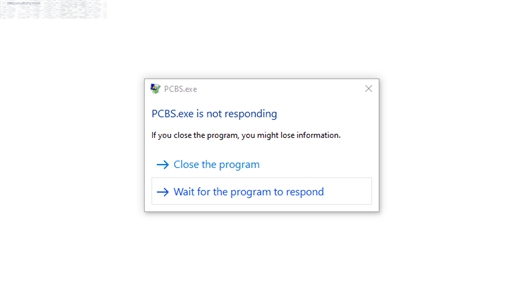
Like srsly what the hell? This happens every time I load the game! It doesn’t even happen on RDR2!
3. QUALITY OF LIFE FEATURES
These are the features that aim to make the game more comfortable, remove nuisances or improve slightly the UX. If there were olympics for the features with the lowest priority, quality of life features would get all the medals. The main reason on why almost zero time is spent on them, is that usually they will have almost zero impact on the KPIs.
But in my experience, it is important to allocate some time to them even if it means generating spaces to work on stuff disregarding priorities (like the hack Fridays practice I mentioned earlier). In my experience, regularly delivering a few QoL features will do wonders with the mood of your community. They are some of the best PR your game team can do to prove to the players that you care about them : )
PCBS is in serious need of quality of life features that make the game more comfortable and remove frustration points. Asking around the game Discord what is most annoying would grant a lot of ideas to add to the plan.

On my side, I’ll say that reviewing the UI for blowing dust would be great, because currently it’s not understandable at all if something is dirty or has been completely cleaned up.

It would also be comfortable if the shop and PC-bay would add an section to quickly check the transit status of pieces (and, in the case of the Shop, a “purchase again” action). Amazon has it :3
OLD PLAYERS (CREATING MEANINGFUL & MONETIZABLE CONTENT)
This is the real deal: The key for PCBS to have a long and successful life lies on it being able to keep advanced players hooked and make them monetize multiple times.
ACCELERATING MEANINGFUL CONTENT PRODUCTION & MONETIZING IT
Right now players are dropping PCBS fast because the game turns very repetitive too fast, and the content is depleted in few hours. No matter what option we choose in terms of monetization, to have a future PCBS needs a flow of regular new content, which means the team has to speed up the production.
But not all the new content is equally effective towards keeping the players engaged.

Most of the content released so far have been new component pieces and cosmetics. While it’s great content, it provides little incentive to play for a longer time. The exception is the eSports Expansion.

In the expansion, the player takes a job as the technician of an eSports team and has to deal with the demands of team athletes, while managing the team budget and sponsorships, and adds the challenge of having limited time to complete quick fixes while there are ongoing matches.
Contrary to everything else that had been released so far, which just a added more of the same, the eSports expansion added a new storyline and multiple new mechanics which are able to keep the player hooked for a longer time, and triggered a lot of activity on the community.
On top of that, it touched a popular theme which helped bringing more visibility to the game, attracting slightly different profile of users (eSport fans with a minor interest on tech) and getting attention of the media.
I haven’t been able to take a look at the revenue of the DLC, but in my opinion, releasing these kind of DLC this is the way to go. Nevertheless, before we jump to pump out endless story DLCs there are three things to take in consideration:
What’s on a DLC?
Even if the ultimate objective is to make that most of the game population buys our new amazing DLCs, freebie players should still feel that the game receives support and have a reason to come back every time there’s a DLC release, even if they’re not planning to purchase it (at least until they come back and see how it is…)
My suggestion would be that these DLCs typically include a new story campaign, a new game mechanic and unique cosmetics (decals for cases, workshop decos…).

Some ideas on possible story-driven DLCs and new mechanics that would suit them.
What’s in for those users that don’t buy it?
Players should have a reason to come back every time there’s a DLC release, even if they’re not planning to purchase it (at least until they come back and see how it is…).
With the distribution that I’ve proposed earlier, this could be achievable this way:

On top of the regularly added parts, players that don’t buy the DLCs will be able to experience the new mechanics albeit in a limited way (i.e. using an alternative data restoration program).

Ideas on DLC visibility: The list of owned and non-owned DLCs should appear in the main menu, subtly suggesting players to buy the ones missing and instantly making them notice if there’s anything new.
How to sustain multiple DLC?
Last, but not least, releasing multiple DLCs that are purchased individually sounds good, but quite quickly it will build up into a situation that is unmanageable and could generate a big entry barrier for new players.

Any player wanting to play a full version of Paradox Interactive grand strategy titles with all the DLCs should better have a big budget, because they ain’t putting it easy to get in…
MONETIZATION SOLUTIONS
Expansion Pass model: Instead of selling every DLC individually (or on top of it), several of the DLCs get mixed into a pack. This allows to make players purchase future content that hasn’t been released yet ; )

Games such as Frostpunk or the Hitman series have opted for this model, which allows big amounts of ontent without necessarily generating a huge entry barrier.
Subscription grants access to DLC: Instead of making people pay for every DLC (or as an alternative to it), they regularly pay a subscription fee which allows them to play DLC content as long as they are members.

This Netflix-like model seems pretty smart, so I’m surprised that I’ve only seen it on Elder Scrolls Online…
WHAT ABOUT OTHER TYPES OF MONETIZATION?
You probably know this already, but there are two main trends when it comes to monetization (which a lot of times work together):
Monetization based on currency scarcity: Where the game has a complex ingame economy and the devs sell a currency which allows access to exclusive premium content or skips timers or boring grinding time.
PROs: Allows people to spend endless amounts of money in short periods of time.
CONs: Very detrimental to the fun of the game itself, because the game has to corner the player to boring situations in order to generate purchases that bring back the fun.
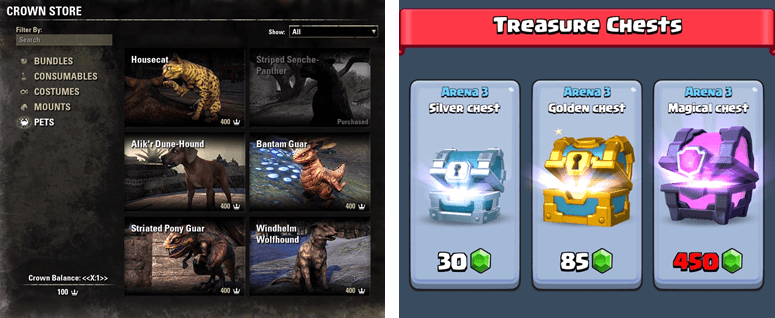
This is the model that most MMOs and F2P mobile games out there use: In Elder Scrolls Online, premium currency allows access to exclusive items. In Clash Royale, upgrading cards requires gold and opening chests, which would take a lot of grinding time that can be skipped by buying them directly.
Selling Battle Pass: Where the player buys the unlocking of the main system of rewards of the game (which may or may not have effects on the gameplay), but then requires the player to stay in the game to collect what he bought.
PROs: This model makes the game more sustainable as a long term hobby (since it doesn’t require massive spending), and is better suited for younger audiences (that don’t have a lot of money to spend but have a lot of time to play).
CONs: The amount spent is smaller, so it requires a bigger population.

This is the primary source of monetization for Fortnite, Apex Legends and Magic Arena, among others.
IMO none of these two ways seem apropiate for PCBS:
Monetizing through currency scarcity is just out of the question, because it requires a complex in-game economy which is absent in PCBS, and it would be a very unnatural fit. Frankly, I can’t think a faster way to kill PCBS fun than to add microtransactions the same way they work on MMOs or mobile games:
What would the player use the currency for? To buy expensive pieces?
This would mean that most of the game the player would be stuck buying the same things over and over, severely limiting the (already small) range of jobs. And adding timers is just obscene.
Battle Pass doesn’t fit either, because it requires the ability to create a lot of rewards, which is something hard to achieve on PCBS. And while cosmetics are a cool thing (i.e. getting decals for existing components or customizations for the workshop), I feel that cosmetics alone wouldn’t be enough incentive to make players pay the pass every month, specially considering that this is not a multiplayer game…
As a consequence, my suggestion would be to focus exclusively on the DLC system for now. And then move the game to free to play in the future (2-3 years) once selling it no longer works as an effective source of income, and the revenue relies almost completely on DLC.
THANKS FOR READING!
It has been challenging (but exciting) to be able to analyze a PC/Console game instead of mobile games. If anyone with more experience on those platform points me to ideas or mistakes I’ve made it would be superb.
Also, if you’re a PCBS player, I’m interested on knowing what’s your take on some of the ideas for future developments on the game I’ve proposed: Do they sound good? You hate them? Do you have even better ideas? Share them
And if you’re not, I strongly recommend you to try it out. Just be warned: it’s a real productivity killer and you may end up having to write a long blog post to justify the insane amount of hours you invest on it!
You can check this article also at https://jb-dev.net/2020/09/02/managing-pc-building-simulator/
Read more about:
Featured BlogsAbout the Author
You May Also Like









